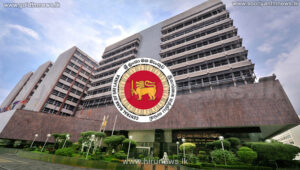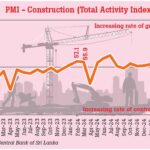
IMF Boost, Export Surge Signal Cautious Economic Recovery for Sri Lanka”
- CNL Reporter
- May 3, 2025
- Weekly Economic Review
- Sri Lanka
- 0 Comments
Weekly Economic Review
Sri Lanka Inches toward Stability with IMF Deal, Surging Remittances, and Export Growth
Sri Lanka has reached a pivotal milestone in its ongoing economic recovery efforts with a staff-level agreement secured on April 25 with the International Monetary Fund (IMF) for the fourth review of its $2.9 billion Extended Fund Facility (EFF). Upon Executive Board approval, this will unlock an additional $344 million, providing crucial liquidity at a time when external debt obligations and macroeconomic stabilization remain top priorities.
This agreement reflects improving economic fundamentals and ongoing structural reforms, and comes amid signs of a recovering economy. Inflation is moderating, GDP growth projections are positive, and the current account has recorded surpluses for three consecutive months. These indicators collectively suggest that Sri Lanka is edging towards macroeconomic stabilization, but significant challenges remain, particularly around fiscal consolidation and the need to implement deeper reforms for sustained growth.
Strategic Reserve Management amid Global Uncertainties
In a noteworthy policy shift aimed at managing risk, the Central Bank of Sri Lanka (CBSL) has transferred part of the Treasury’s foreign reserves previously held in the United States to the Bank for International Settlements (BIS) in Switzerland in 2024. This move was explained as a risk diversification effort given global financial volatility.
The funds, held under the Deputy Treasury Secretary (DST), stood at $106.11 million by the end of 2024. Unlike in previous IMF engagements, where funds were used to rebuild central bank reserves, the current tranche of IMF funding is directed to the Treasury, allowing for more direct use in external debt servicing and fiscal obligations.
Switzerland’s stable monetary environment and sound central banking history make it a strategically safe destination. This realignment highlights Sri Lanka’s shifting approach towards more conservative and risk-managed reserve allocation.
Export Growth and Remittance Surge Drive External Resilience

Sri Lanka’s foreign exchange earnings rose sharply to $2.6 billion in March 2025, up from $2.36 billion a year earlier. This growth was driven by robust worker remittances and hard goods exports.
Worker remittances hit a record high of $693 million in March, representing a 21.1% year-on-year increase, with cumulative Q1 inflows totaling $1.81 billion—a rise of 18.1% compared to the previous year. This growth is attributed in part to continued migration driven by the prior economic crisis and the devaluation of real wages.
Gross services exports, including tourism, reached $665 million, while tourism earnings alone totaled $354 million in March, benefiting from the peak winter travel season. However, outbound travel by Sri Lankans also rose to $68.8 million, indicating increased disposable income and economic normalization.
For the third straight month, Sri Lanka’s current account posted a surplus—$459.5 million in March, up 76.8% year-on-year, bringing the Q1 current account surplus to $949 million. This marks a notable turnaround from persistent deficits in recent years and adds to the growing evidence of improved external sector health.
Trade Deficit Narrows amid Shifting Terms of Trade
Despite the gains, the merchandise trade deficit widened modestly to $395.6 million in March, though still an improvement over previous months. Notably, hard goods exports climbed to $1.24 billion from $1.05 billion, likely driven by pre-April holiday inventory build-up by U.S. buyers.
Imports recovered to $1.64 billion in March, up from $1.56 billion in February, reflecting an uptick in domestic demand and consumption as credit conditions eased.
The terms of trade slightly improved, as import prices fell more sharply than export prices, according to the CBSL. This narrowing trade gap, alongside rising remittance and tourism income, is helping to stabilize the exchange rate, as long as domestic credit expansion remains in check.
Central Bank Posts Profits but Faces Legacy Costs

The Central Bank of Sri Lanka reported profits of LKR 274 billion in 2024, a positive turnaround largely driven by interest income from foreign assets and its bond portfolio. However, the legacy of inflationary policy from 2019–2022—including the central bank’s purchase of over LKR 3 trillion in Treasury bills—continues to weigh on financial accounts.
To comply with IMF restructuring requirements, these high-yielding bills were converted into lower-interest, step-down bonds, triggering a book loss in 2023. The restructured instruments were essential to avoid a broader default and meet IMF’s gross financing needs, drawing parallels to restructuring seen in countries like Ghana.
As a result, the CBSL’s domestic asset base shrank from LKR 2,044 billion to LKR 1,748 billion by the end of 2024. Despite this contraction, monetary stability achieved post-September 2022 has allowed for more measured policy action.
U.S. Import Tax Sparks Cost Concerns for Exporters
On the trade front, Sri Lankan exporters are now grappling with a new 10% U.S. import tax, prompting urgent discussions between U.S. buyers and local manufacturers to share the burden and prevent end-consumer price hikes.
During the April holidays, major U.S. brands initiated talks with leading exporters like Brandix to explore cost-reduction strategies. According to Brandix’s Managing Director Hasitha Premaratne, discussions have included inquiries into government responses and support mechanisms to cushion the tax impact.

Global commodity price trends could offer some relief. Since the U.S. Federal Reserve began tightening monetary policy in 2022, energy and cotton prices have declined, driven by a broader deflationary slowdown. These cost reductions could help local exporters remain competitive despite added tax burdens.
Outlook: Cautious Optimism with Persistent Risks
While Sri Lanka’s economic indicators reflect a degree of stability and resilience—buoyed by IMF support, higher remittances, tourism, and exports—the road ahead remains uncertain. The ongoing need for structural reforms, effective reserve management, and cautious monetary policy will define whether this recovery is sustained.
With fresh IMF funding on the horizon, continued foreign inflows, and signs of fiscal prudence, Sri Lanka may be entering a fragile but hopeful phase in its post-crisis recovery. However, any slip in discipline—particularly on inflation or public finance—could derail these hard-won gains.

